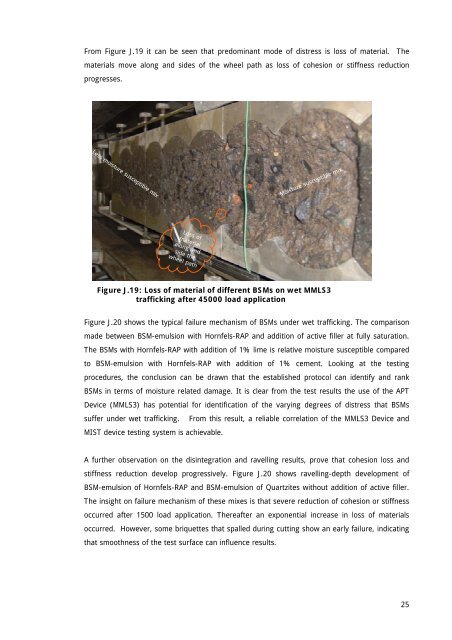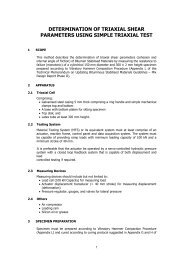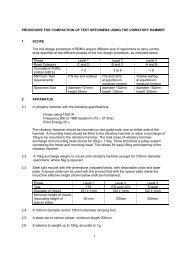Updating Bituminous Stabilized Materials Guidelines Mix Design Report Phase II
Moisture Sensitivity: Part II (Validation) - Asphalt Academy
Moisture Sensitivity: Part II (Validation) - Asphalt Academy
- No tags were found...
Create successful ePaper yourself
Turn your PDF publications into a flip-book with our unique Google optimized e-Paper software.
From Figure J.19 it can be seen that predominant mode of distress is loss of material. The<br />
materials move along and sides of the wheel path as loss of cohesion or stiffness reduction<br />
progresses.<br />
Less moisture susceptible mix<br />
Moisture susceptible mix<br />
Loss of<br />
material<br />
along and<br />
side the<br />
wheel path<br />
Figure J.19: Loss of material of different BSMs on wet MMLS3<br />
trafficking after 45000 load application<br />
Figure J.20 shows the typical failure mechanism of BSMs under wet trafficking. The comparison<br />
made between BSM-emulsion with Hornfels-RAP and addition of active filler at fully saturation.<br />
The BSMs with Hornfels-RAP with addition of 1% lime is relative moisture susceptible compared<br />
to BSM-emulsion with Hornfels-RAP with addition of 1% cement. Looking at the testing<br />
procedures, the conclusion can be drawn that the established protocol can identify and rank<br />
BSMs in terms of moisture related damage. It is clear from the test results the use of the APT<br />
Device (MMLS3) has potential for identification of the varying degrees of distress that BSMs<br />
suffer under wet trafficking. From this result, a reliable correlation of the MMLS3 Device and<br />
MIST device testing system is achievable.<br />
A further observation on the disintegration and ravelling results, prove that cohesion loss and<br />
stiffness reduction develop progressively. Figure J.20 shows ravelling-depth development of<br />
BSM-emulsion of Hornfels-RAP and BSM-emulsion of Quartzites without addition of active filler.<br />
The insight on failure mechanism of these mixes is that severe reduction of cohesion or stiffness<br />
occurred after 1500 load application. Thereafter an exponential increase in loss of materials<br />
occurred. However, some briquettes that spalled during cutting show an early failure, indicating<br />
that smoothness of the test surface can influence results.<br />
25












